-

新人教版高中英语必修3Unit 5 The Value of Money-Reading for Writing教学设计二
2. 您能看到, 我头发太长了。You can see that my hair is much too long.3. 无论什么时候, 只要您想回来就回来。Please come back whenever you want.4. 您仅有很少的头发要理! You only have too little hair to cut !5. 为您服务是我的荣幸!It is my honour to serve you!Step 9 Writing(Henry is walking down the street when he sees a sign for a place that cuts hair. He decides to have it cut. )H=Henry B=BarberH: Good afternoon, I’d like to have my hair cut, if I may. (The barber looks at Henry’s hair and continues cutting another man’s hair. ) Er, I’d really like a haircut. As you can see it’s much too long. B: (in a rude manner) Yes, I can see that. Indeed, I can. H: Fine, well, I’ll have a seat then. (He sits in one of the barber’s chairs. The barber turns to look at Henry. )B: It’s quite expensive here, you know! Are you sure you can afford it?H: Yes. I think so. (After his hair is cut, the barber tells Henry how much he must pay. Henry shows the barber the bank note. )B: Why Mr. . . (looks shocked)H: Adams. Henry Adams. I’m sorry. I don’t have any change. B: Please don’t worry! (wearing a big smile) Nothing to worry about! Nothing at all! Please come back whenever you want, even if you only have too little hair to cut! It will be my honour to serve you!Step 10 Pair workExchange drafts with a partner. Use this checklist to help your partner revise his/her draft.1. Are all the elements of a play included and in good order ?2. Do the character use suitable language ?3. Are the stage directions clear and useful ?4. Is the plot clear and exciting enough ?

新人教版高中英语必修3Unit 5 the value of money-Reading For Writing教学设计一
【参考范文】Narrator:(Henry is smiling as he leaves the restaurant. As he is walking down the street, he sees a sign for a place that cuts hair. He decides to get it cut. )H=Henry;B=Barber;R=rude manH:Good afternoon, I'd like to get a cut, if I may. (The barber looks at Henry's hair and continues cutting another man's hair. )Er, I'd really like a haircut. As you can see it's much too long. B:(in a rude manner) Yes, I can see that. Indeed, I can. H:Fine, well I'll have a seat then. (He sits in one of the barber's chairs. The barber turns to look at Henry. )B:It's quite expensive here, you know!Are you sure you can afford it?H:Yes. I think so. (In comes the rude man. )R:Hey you there. I need a haircut quickly. Can you do me straightaway?B:All right, then, get in the chair and I'll see what I can do. R:Thank you. (sits down in one of the barber's chairs)H:Excuse me, but I was here first. Aren't you going to do my hair first?B:This man's in a hurry. H:Well so am I!I insist that you cut my hair first. B:OK, but I'll have to be quick. This gentleman is waiting. H:Thank you. (They both become quiet. After his hair is cut, the barber tells Henry how much he must pay. Henry shows the barber the bank note. )B:Why, Mr . . . (looks shocked)H:Adams. Henry Adams. I'm sorry, I don't have any change. R:You're that Mr Adams! Well,I'm glad I waited or I might never have known it was you. B:Why, Mr Adams, please don't worry!(wearing a big smile) Nothing to worry about!Nothing at all!Please come back any time, even if you only need too little hairs cut!It will be my honour to serve you!

新人教版高中英语选修2Unit 1 Science and Scientists-Discovering useful structures教学设计
The grammatical structure of this unit is predicative clause. Like object clause and subject clause, predicative clause is one of Nominal Clauses. The leading words of predicative clauses are that, what, how, what, where, as if, because, etc.The design of teaching activities aims to guide students to perceive the structural features of predicative clauses and think about their ideographic functions. Beyond that, students should be guided to use this grammar in the context apporpriately and flexibly.1. Enable the Ss to master the usage of the predicative clauses in this unit.2. Enable the Ss to use the predicative patterns flexibly.3. Train the Ss to apply some skills by doing the relevant exercises.1.Guide students to perceive the structural features of predicative clauses and think about their ideographic functions.2.Strengthen students' ability of using predicative clauses in context, but also cultivate their ability of text analysis and logical reasoning competence.Step1: Underline all the examples in the reading passage, where noun clauses are used as the predicative. Then state their meaning and functions.1) One theory was that bad air caused the disease.2) Another theory was that cholera was caused by an infection from germs in food or water.3) The truth was that the water from the Broad Street had been infected by waste.Sum up the rules of grammar:1. 以上黑体部分在句中作表语。2. 句1、2、3中的that在从句中不作成分,只起连接作用。 Step2: Review the basic components of predicative clauses1.Definition

新人教版高中英语选修2Unit 1 Science and Scientists-Learning about Language教学设计
Step 7: complete the discourse according to the grammar rules.Cholera used to be one of the most 1.__________ (fear) diseases in the world. In the early 19th century, _2_________ an outbreak of cholera hit Europe, millions of people died. But neither its cause, 3__________ its cure was understood. A British doctor, John Snow, wanted to solve the problem and he knew that cholera would not be controlled _4_________ its cause was found. In general, there were two contradictory theories 5 __________ explained how cholera spread. The first suggested that bad air caused the disease. The second was that cholera was caused by an _6_________(infect) from germs in food or water. John Snow thought that the second theory was correct but he needed proof. So when another outbreak of cholera hit London in 1854, he began to investigate. Later, with all the evidence he _7_________ (gather), John Snow was able to announce that the pump water carried cholera germs. Therefore, he had the handle of the pump _8_________ (remove) so that it couldn't be used. Through his intervention,the disease was stopped in its tracks. What is more, John Snow found that some companies sold water from the River Thames that __9__________________ (pollute) by raw waste. The people who drank this water were much more likely _10_________ (get) cholera than those who drank pure or boiled water. Through John Snow's efforts, the _11_________ (threaten) of cholera around the world saw a substantial increase. Keys: 1.feared 2.when 3. nor 4.unless 5.that/which 6.infection 7.had gathered 8.removed 9.was polluted 10.to get 11. threat

新人教版高中英语选修2Unit 1 Science and Scientists-Reading and thinking教学设计
Step 5: After learning the text, discuss with your peers about the following questions:1.John Snow believed Idea 2 was right. How did he finally prove it?2. Do you think John Snow would have solved this problem without the map?3. Cholera is a 19th century disease. What disease do you think is similar to cholera today?SARS and Covid-19 because they are both deadly and fatally infectious, have an unknown cause and need serious public health care to solve them urgently.keys:1. John Snow finally proved his idea because he found an outbreak that was clearly related to cholera, collected information and was able to tie cases outside the area to the polluted water.2. No. The map helped John Snow organize his ideas. He was able to identify those households that had had many deaths and check their water-drinking habits. He identified those houses that had had no deaths and surveyed their drinking habits. The evidence clearly pointed to the polluted water being the cause.3. SARS and Covid-19 because they are both deadly and fatally infectious, have an unknown cause and need serious public health care to solve them urgently.Step 6: Consolidate what you have learned by filling in the blanks:John Snow was a well-known _1___ in London in the _2__ century. He wanted to find the _3_____ of cholera in order to help people ___4_____ it. In 1854 when a cholera __5__ London, he began to gather information. He ___6__ on a map ___7___ all the dead people had lived and he found that many people who had ___8____ (drink) the dirty water from the __9____ died. So he decided that the polluted water ___10____ cholera. He suggested that the ___11__ of all water supplies should be _12______ and new methods of dealing with ____13___ water be found. Finally, “King Cholera” was __14_____.Keys: 1. doctor 2. 19th 3.cause 4.infected with 5.hit 6.marked 7.where 8.drunk 9.pump 10.carried 11.source 12.examined 13.polluted 14.defeatedHomework: Retell the text after class and preview its language points

新人教版高中英语选修2Unit 2 Bridging Cultures-Discovering useful structures教学设计
The grammar of this unit is designed to review noun clauses. Sentences that use nouns in a sentence are called noun clauses. Nominal clauses can act as subject, object, predicate, appositive and other components in compound sentences. According to the above-mentioned different grammatical functions, nominal clauses are divided into subject clause, object clause, predicate clause and appositive clause. In this unit, we will review the three kinds of nominal clauses. Appositive clauses are not required to be mastered in the optional compulsory stage, so they are not involved.1. Guide the students to judge the compound sentences and determine the composition of the clauses in the sentence.2. Instruct students to try to learn grammar by generalizing grammar rules, controlling written practice, and semi-open oral output.3. Inspire the students to systematize the function and usage of noun clause1.Instruct students to try to learn grammar by generalizing grammar rules, controlling written practice, and semi-open oral output.2.Inspire the students to systematize the function and usage of noun clauseStep1: The teacher ask studetns to find out more nominal clauses from the reading passage and udnerline the nominal clauses.

新人教版高中英语选修2Unit 3 Food and Culture-Reading and thinking教学设计
The discourse explores the link between food and culture from a foreign’s perspective and it records some authentic Chinese food and illustrates the cultural meaning, gerography features and historic tradition that the food reflects. It is aimed to lead students to understand and think about the connection between food and culture. While teaching, the teacher should instruct students to find out the writing order and the writer’s experieces and feelings towards Chinese food and culture.1.Guide the students to read the text, sort out the information and dig out the topic.2.Understand the cultural connotation, regional characteristics and historical tradition of Chinese cuisine3.Understand and explore the relationship between food and people's personality4.Guide the students to use the cohesive words in the text5.Lead students to accurately grasp the real meaning of the information and improve the overall understanding ability by understanding the implied meaning behind the text.1. Enable the Ss to understand the structure and the writing style of the passage well.2. Lead the Ss to understand and think further about the connection between food and geography and local character traits.Step1: Prediction before reading. Before you read, look at the title, and the picture. What do you think this article is about?keys:It is about various culture and cuisine about a place or some countries.
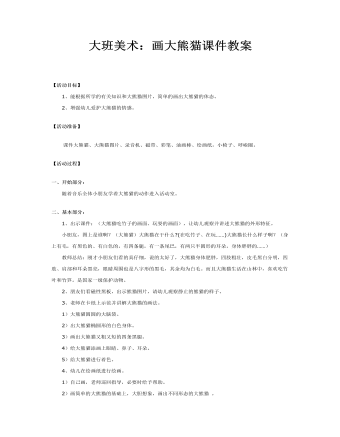
大班美术:画大熊猫课件教案
【活动准备】 课件大熊猫、大熊猫图片、录音机、磁带、彩笔、油画棒、绘画纸,小椅子、呼啦圈。【活动过程】一、开始部分: 随着音乐全体小朋友学着大熊猫的动作进入活动室。二、基本部分:1、出示课件:(大熊猫吃竹子的画面、玩耍的画面),让幼儿观察并讲述大熊猫的外形特征。 小朋友,图上是谁啊?(大熊猫)大熊猫在干什么?(在吃竹子、在玩……)大熊猫长什么样子啊?(身上有毛,有黑色的、有白色的,有四条腿,有一条尾巴,有两只半圆形的耳朵,身体胖胖的……) 教师总结:刚才小朋友们看的真仔细,说的太好了,大熊猫身体肥胖,四肢粗壮,皮毛黑白分明,四肢、肩部和耳朵黑亮,眼睛周围也是八字形的黑毛,其余均为白毛。而且大熊猫生活在山林中,喜欢吃竹叶和竹笋。是国家一级保护动物。2、朋友们看磁性黑板,出示熊猫图片,请幼儿观察静止的熊猫的样子。3、老师在卡纸上示范并讲解大熊猫的画法。1)大熊猫圆圆的大脑袋。2)出大熊猫椭圆形的白色身体。3)画出大熊猫又粗又短的四条黑腿。4)给大熊猫添画上眼睛、鼻子、耳朵。5)给大熊猫进行着色。4、幼儿在绘画纸进行绘画。1)自己画,老师巡回指导,必要时给予帮助。2)画简单的大熊猫的基础上,大胆想象,画出不同形态的大熊猫。3)为大熊猫添画竹笋、竹叶等。4)给大熊猫进行着色。注意画面的整洁,涂色要均匀。
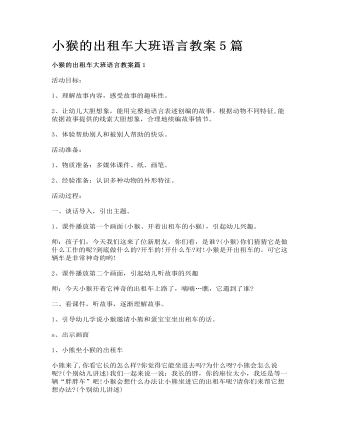
小猴的出租车大班语言教案5篇
1、讲述故事,加深理解。教师操作教具,讲述故事,穿插提问:a小猴发现蛋宝宝和小熊遇到什么困难?如果你是小猴你会怎样解决这个问题?请小朋友积极想办法。b小朋友听故事里的小猴是怎样做的。乘客对小猴设计的出租车是否“满意”(出示字卡满意),为什么?你们喜欢小猴和它的出租车吗?是否也“满意”?2、大胆想象仿编故事。引发仿编兴趣:小猴的名气越来越大了,森林里的小动物都来坐它的出租车。提问:长颈鹿和小刺猬遇到了什么困难?小猴是怎样解决的?森林里还有谁也乘坐小猴的出租车?他们可能遇到什么困难?小猴能解决吗?我们也帮小猴想想让所有的小动物都能顺利的乘坐出租车。(幼儿分组讨论,仿编故事,鼓励幼儿把故事讲给大家听。)
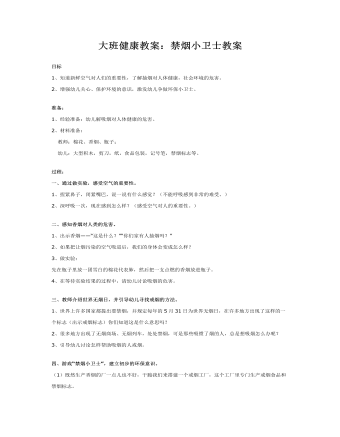
大班健康教案:禁烟小卫士教案
准备: 1、经验准备:幼儿解吸烟对人体健康的危害。 2、材料准备: 教师:棉花、香烟、瓶子; 幼儿:大型积木,剪刀,纸,食品包装,记号笔,禁烟标志等。 过程: 一、通过做实验,感受空气的重要性。 1、捏紧鼻子,闭紧嘴巴,说一说有什么感觉?(不能呼吸感到非常的难受。) 2、深呼吸一次,现在感到怎么样?(感受空气对人的重要性。) 二、感知香烟对人类的危害。 1
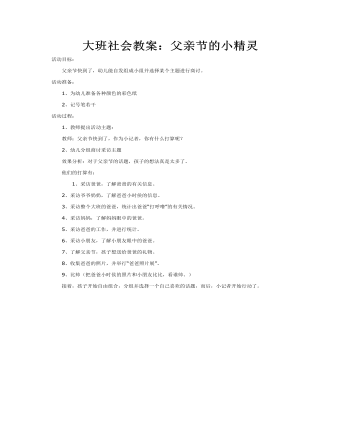
大班社会教案:父亲节的小精灵
1、为幼儿准备各种颜色的彩色纸2、记号笔若干活动过程:1、教师提出活动主题: 教师:父亲节快到了,作为小记者,你有什么打算呢?2、幼儿分组商讨采访主题 效果分析:对于父亲节的话题,孩子的想法真是太多了。
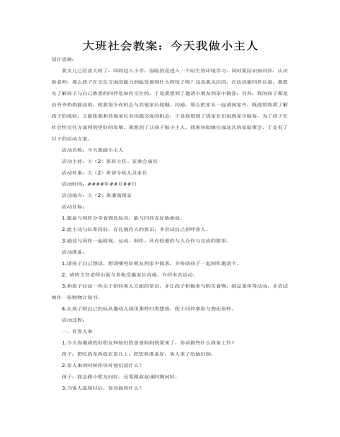
大班社会教案:今天我做小主人
活动名称:今天我做小主人 活动主持:大(2)班班主任、家委会成员 活动对象:大(2)班部分幼儿及家长 活动时间:####年##月##日 活动地点:大(2)班潘瑞珺家 活动目标:1.愿意与同伴分享食物及玩具,能与同伴友好地相处。2.能主动与长辈问好,有礼貌待人的意识,并尝试自己招呼客人。3.通过与同伴一起游戏、运动、制作,具有较强的与人合作与交流的愿望。 活动准备:1.请孩子自己预设,想请哪些好朋友到家中做客,并协助孩子一起制作邀请卡。2. 请班主任老师出面与其他受邀家长沟通,介绍本次活动。3.和孩子讨论一些关于招待客人方面的常识,并让孩子积极参与购买食物、制定菜单等活动,并尝试制作一张购物计划书。4.让孩子将自己的玩具像幼儿园里那样归类摆放,便于同伴拿取与物还原样。
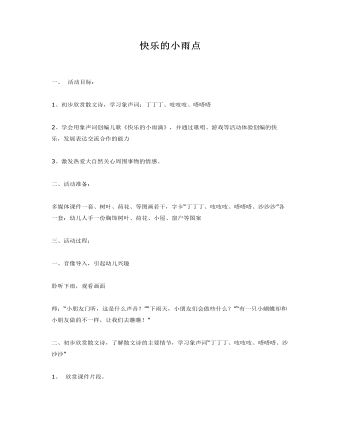
大班音乐教案:快乐的小雨点
2、学会用象声词创编儿歌《快乐的小雨滴》,并通过歌唱、游戏等活动体验创编的快乐,发展表达交流合作的能力3、激发热爱大自然关心周围事物的情感。二、活动准备:多媒体课件一套、树叶、荷花、等图画若干,字卡“丁丁丁、吱吱吱、嗒嗒嗒、沙沙沙”各一套:幼儿人手一份胸饰树叶、荷花、小屋、窗户等图案三、活动过程:一、音像导入,引起幼儿兴趣聆听下雨,观看画面师:“小朋友门听,这是什么声音?”“下雨天,小朋友们会做些什么?”“有一只小蝴蝶却和小朋友做的不一样,让我们去瞧瞧!”
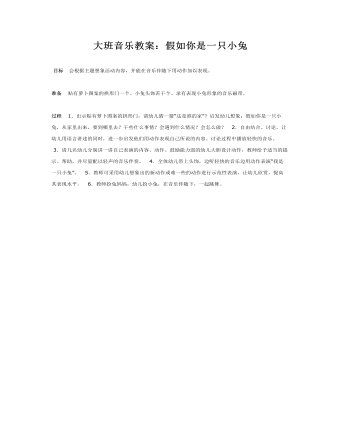
大班音乐教案:假如你是一只小兔
准备 贴有萝卜图案的拱形门一个、小兔头饰若干个、录有表现小兔形象的音乐磁带。 过程 1.出示贴有萝卜图案的拱形门,请幼儿猜一猜“这是谁的家”?启发幼儿想象:假如你是一只小兔,从家里出来,要到哪里去?干些什么事情?会遇到什么情况?会怎么做? 2.自由结合、讨论。让幼儿用语言讲述的同时,进一步启发他们用动作表现自己所说的内容。讨论过程中播放轻快的音乐。
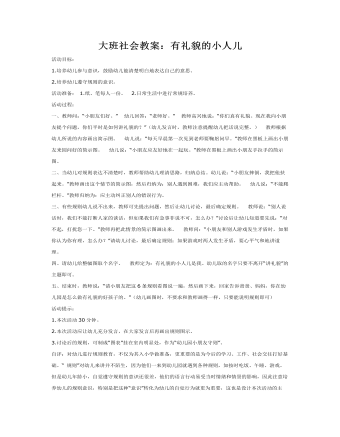
大班社会教案:有礼貌的小人儿
一、教师问:“小朋友们好。” 幼儿回答:“老师好。” 教师高兴地说:“你们真有礼貌。现在我向小朋友提个问题,你们平时是如何讲礼貌的?”(幼儿发言时,教师注意提醒幼儿把话说完整。) 教师根据幼儿所说的内容画出简示图。 幼儿说:“每天早晨第一次见到老师要鞠躬问早。”教师在黑板上画出小朋友来园问好的简示图。 幼儿说:“小朋友应友好地在一起玩。”教师在黑板上画出小朋友手拉手的简示图。 二、当幼儿对规则表达不清楚时,教师帮助幼儿理清思路,归纳总结。幼儿说:“小朋友摔倒,我把他扶起来。”教师画出这个情节的简示图,然后归纳为:别人遇到困难,我们应主动帮助。 幼儿说:“不能爬栏杆。”教师归纳为:应主动纠正别人的错误行为。
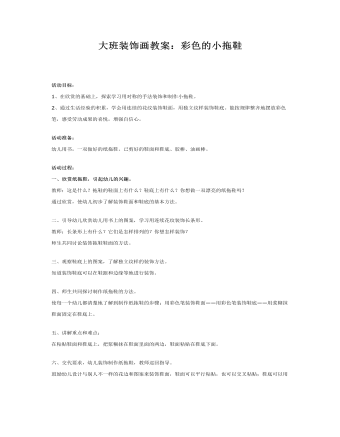
大班装饰画教案:彩色的小拖鞋
2、通过生活经验的积累,学会用连续的花纹装饰鞋面,用独立纹样装饰鞋底。能按规律整齐地摆放彩色笔,感受劳动成果的喜悦,增强自信心。活动准备:幼儿用书,一双做好的纸拖鞋。已剪好的鞋面和鞋底、胶棒、油画棒。活动过程:一、欣赏纸拖鞋,引起幼儿的兴趣。 教师:这是什么?拖鞋的鞋面上有什么?鞋底上有什么?你想做一双漂亮的纸拖鞋吗? 通过欣赏,使幼儿初步了解装饰鞋面和鞋底的基本方法。 二、引导幼儿欣赏幼儿用书上的图案,学习用连续花纹装饰长条形。 教师:长条形上有什么?它们是怎样排列的?你想怎样装饰? 师生共同讨论装饰拖鞋鞋面的方法。
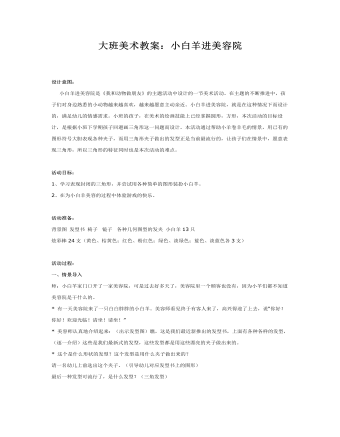
大班美术教案:小白羊进美容院
活动目标:1、学习表现封闭的三角形,并尝试用各种简单的图形装扮小白羊。2、在为小白羊美容的过程中体验游戏的快乐。 活动准备:背景图发型书椅子 镜子 各种几何图型的发夹小白羊13只炫彩棒24支(黄色、桔黄色;红色、粉红色;绿色、淡绿色;蓝色、淡蓝色各3支)
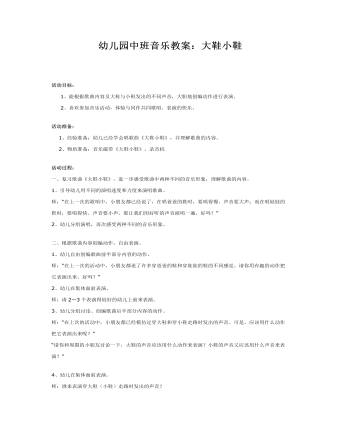
幼儿园中班音乐教案:大鞋小鞋
活动准备: 1、经验准备:幼儿已经学会唱歌曲《大鞋小鞋》,并理解歌曲的内容。 2、物质准备:音乐磁带《大鞋小鞋》、录音机活动过程:一、复习歌曲《大鞋小鞋》,进一步感受歌曲中两种不同的音乐形象,理解歌曲的内容。 1、引导幼儿用不同的演唱速度和力度来演唱歌曲。 师:“在上一次的歌唱中,小朋友都已经说了,在唱爸爸的鞋时,要唱得慢、声音要大声;而在唱娃娃的鞋时,要唱得快、声音要小声。那让我们用好听的声音演唱一遍,好吗?” 2、幼儿分组演唱,再次感受两种不同的音乐形象。二、根据歌曲内容创编动作,自由表演。 1、幼儿自由创编歌曲前半部分内容的动作。 师:“在上一次的活动中,小朋友都说了许多穿爸爸的鞋和穿娃娃的鞋的不同感觉。请你用有趣的动作把它表演出来,好吗?”
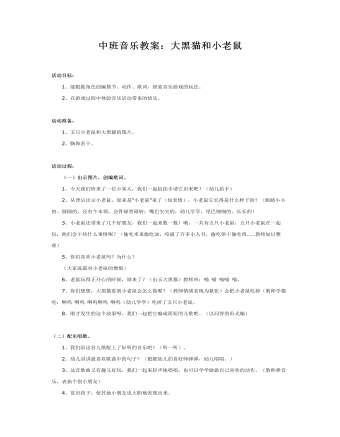
中班音乐教案:大黑猫和小老鼠
活动准备:1、五只小老鼠和大黑猫的图片。2、胸饰若干。 活动过程:(一)出示图片,创编歌词。1、今天我们班来了一位小客人,我们一起拍拍手请它出来吧!(幼儿拍手)2、从背后出示小老鼠,原来是“小老鼠”来了(加表情),小老鼠它长得是什么样子的?(眼睛小小的、圆圆的,还有个本领,会骨碌骨碌转;嘴巴尖尖的,幼儿学学,尾巴细细的、长长的)
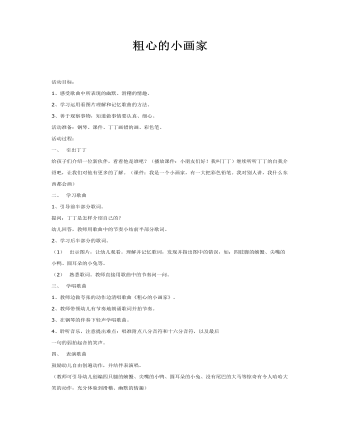
大班音乐教案:粗心的小画家
活动过程: 一、 引出丁丁 给孩子们介绍一位新伙伴,看看他是谁吧?(播放课件:小朋友们好!我叫丁丁)继续听听丁丁的自我介绍吧,让我们对他有更多的了解。(课件:我是一个小画家,有一大把彩色铅笔。我对别人讲,我什么东西都会画) 二、 学习歌曲 1、引导前半部分歌词。 提问:丁丁是怎样介绍自己的? 幼儿回答,教师用歌曲中的节奏小结前半部分歌词。 2、学习后半部分的歌词。 (1) 出示图片,让幼儿观看。理解并记忆歌词,发现并指出图中的错误,如:四肢脚的螃蟹、尖嘴的小鸭、圆耳朵的小兔等。 (2) 熟悉歌词。教师直接用歌曲中的节奏问一问。

